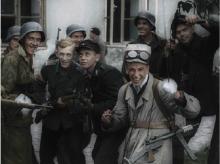
|
"Warsaw Uprising” is probably the world’s first war documentary film made entirely from original archive materials. It tells the story of the Warsaw Uprising of 1944 through the eyes of US airman and two young reporters, witnesses to insurgent fighting. It uses authentic newsreels filmed in August of 1944. Applying modern technology of restoring, colorization and expertize of speech readers and ensuring the co-operation of the best artists, the “Warsaw Uprising” has no comparable project in the World.
Six hours of original newsreel footage from the Warsaw Uprising of 1944, six months of work, a team of military, clothing and architecture consultants, urban planners, Warsaw experts and historians, thousands of color editing consulting hours, 1,200 shots, 1,440 hours of colorizing and reconstruction, 112,000 selected frames, 648,000 minutes of film frames reconstruction, 22,971,520 megabytes of data – these are only a few numbers which help appreciate the enormous effort and means dedicated to this Uprising project.
Reserve your seats: Melbourne warsawuprising.au@gmail.com
Sydney marta.kiec-gubala@msz.gov.pl or ring 9327 8600.
Information in Polish - here
The result is an 87-minute completely restored, colored and extremely touching film, which shows the Warsaw Uprising with unparalleled realism.
“Warsaw Uprising” came into being thanks to Jan Ołdakowski, Director of the Warsaw Uprising Museum, and Piotr C. ¦liwowski, Head of the History Department at the Museum. Jan Komasa, the director, came up with the idea for this original storyline. Dialogues were written by Joanna Pawlu¶kiewicz, Michał Sufin and Władysław Pasikowski. Actors enlisted for the project included: Jeff Burrell, Piotr Adamczyk, Józef Pawłowski. Their voices can be heard in the film. Colorizing work was supervised by a renowned Polish cameraman Piotr Sobociński Jr. Screenwriting was done collectively by Jan Ołdakowski, Piotr C. ¦liwowski and Joanna Pawlu¶kiewicz while Joanna Brühl and Milenia Fiedler served as editors. The music was composed by Bartosz Chajdecki.
Bartosz Putkiewcz, Kacper Habisiak and Marcin Kasiński were responsible for providing sound for what had been, until now, a completely silent documentary material. Fragmentary nature of the surviving newsreel material, constituted one of the key stages in the production process. The film creators wanted to show more than just the historical event; first, and above all, they wanted to show the people who were part of it. “Insurgents appear on the screen too briefly to fully tell their story. This sparked the idea of the film protagonist to be a person who does not appear in the take, but whose presence, emotions and actions are recorded by the camera operator on film.” – says Milenia Fiedler.
Striving for the best quality of the colored image, the Warsaw Uprising Museum announced a competition for coloring and post-production of the Uprising newsreels. A jury headed by Witold Sobociński selected the Orka Studio for this task. The first stage of the process involved stabilization, which required finding points of reference for each take and eliminating shaking of the image. In the next step, restoration of the material took place, including initial color correction of the black and white material, stabilization and removal of image pulsation and imperfections of the film exposure. The work also involved manually repairing image deformations, removing dirt, dust and film damages and achieving grain control.
Next the film was colored. Proper coloring of the “Warsaw Uprising” constituted a great challenge. Before starting the this phase a reference base was gathered of several thousand photographs of weapons and armament, uniforms, equipment, civilian clothing, urban infrastructure, signs, several hundred photographs of different types of setts, flagstones etc. Historical accuracy was overseen by historians from the Warsaw Uprising Museum, experts in urban studies and architecture, Warsaw specialists and consultants in weaponry and armament co-operating with the Warsaw Uprising Museum.
The film was colored using unique software, invented and created in Hollywood. Because of the fact that the material utilized in “Warsaw Uprising” was greatly worn out or damaged (most likely due to developing in difficult conditions and improper storing), it was hard in many cases to select right color. Each take after preliminary coloring required detailed description and countless consultations with history experts.
After standard colorization was completed the film producers invited a well-known Director of Photography, Piotr Sobociński Jr., to work on the film, who as color grading supervisor was responsible for the film’s credibility and unifying colors applied in post-production.
From: warsawrising-thefilm.com/ |


